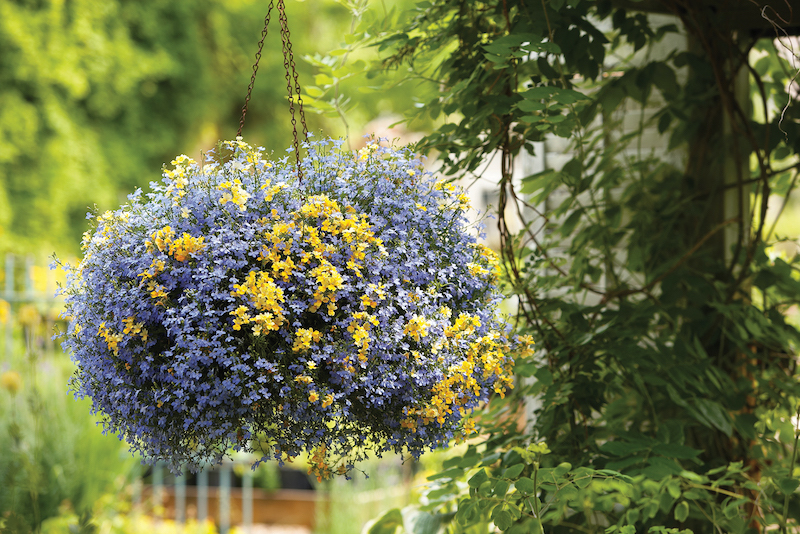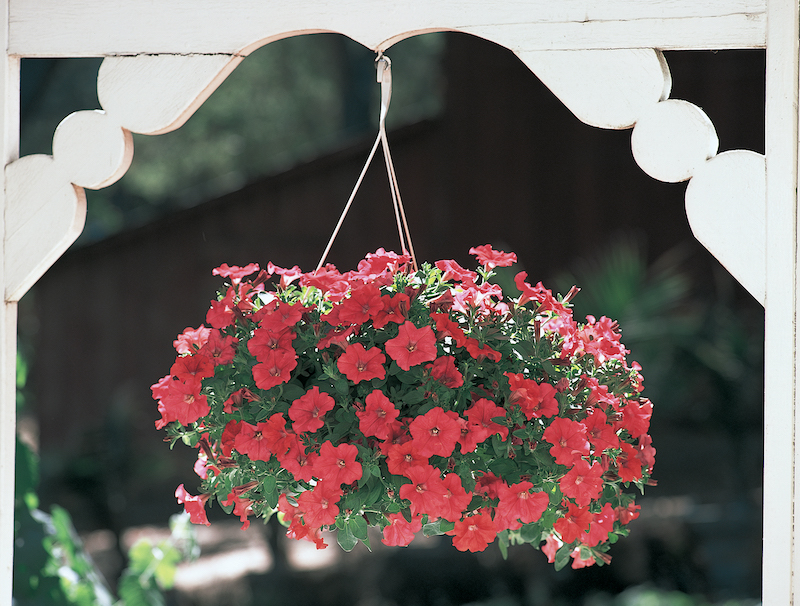Hanging baskets full of colorful flowering annuals, herbs, or other edible plants can add another dimension to a patio, deck, or garden landscape when hung from trees or shepherd’s hooks. Hanging plants can be used to multiply the growing area for a balcony garden or used in multiples to screen the front porch on a busy street. Plants for hanging baskets can be just about any mix of annuals or small perennials with shallow roots and can be changed to suit the seasons or the gardener's taste. The same concept of a thriller, spiller, and filler plant in container plantings can be used for hanging baskets to give dimension and a dense, lush look.

Planting Hanging Baskets
Choose plants with the same light and water requirements when composing a mixed hanging basket. Sunny plants like petunias and verbena will not grow well with shade lovers such as lobelia and tuberous begonias. Growing herbs alongside flowering annuals can be a very effective use of a small space while also being very decorative. The larger hanging baskets, 12-20 inches in diameter, will allow more plants to be grown together. The smaller baskets are great for growing single plants that don’t like to compete for root space.
Hanging baskets are typically planted and hung in the spring after all danger of frost has passed for your growing zone. If an unseasonable frost is predicted, bring your hanging baskets into a sheltered spot like a garage or unheated greenhouse for a night. This also is beneficial late in the season to protect any still thriving baskets from early frosts.
Ensure that any hanging basket has excellent drainage. Plastic pots often have a shallow drip tray attached to the bottom, which is easily removed to increase drainage. Wire hanging baskets are lined with a coconut coir liner or moss and have excellent drainage and airflow for the roots, although they tend to dry out faster in the heat of summer.

Best Soil For Hanging Baskets
Refrain from using soil from the garden. It has fewer air pores for good circulation around the roots. After watering, the immense weight of garden soil makes it a poor choice for hanging pots. An all-purpose, soil-free potting mix with added perlite is lightweight soil and holds moisture well. Fresh soil each season will ensure that diseases do not infect your hanging baskets.
Caring For Hanging Baskets
Hanging baskets require much more care than even plants in containers on the ground. Often, baskets are subjected to more wind or sun than garden plants and will require far more watering and fertilizing to thrive all season long.

Watering Hanging Baskets
Watering is the most important part of caring for your hanging basket and may need to be done daily in hot or dry weather. There are two ways to test a basket for watering. Stick your finger in the soil to see if the first inch is dry. If the basket is hanging too high, the bottom of it can be gently lifted from the bottom. A well-watered basket will feel heavier than a basket that needs water. Gently wet the soil surface until water runs from the bottom of the basket. Often using a long-handled watering wand connected to a garden hose is the quickest and most efficient method for watering high-hanging baskets.
Fertilizing Hanging Baskets
Use a diluted liquid fertilizer when feeding hanging baskets. These products act quickly and are easier to dial up or down than a slow-release formulation. Organic seaweed or fish emulsion solutions are the safest to use if you are growing edible plants in baskets. Ensure that all plants in the basket are well watered before adding fertilizer. Even a diluted feed can harm a stressed plant. Depending on the plants, hanging baskets usually benefit from feeding at 2-week intervals. The shallow nature of baskets and their need to be water so often means that any nutrients are quickly leached from the soil.
Winter Care For Hanging Baskets
Hanging baskets should be emptied and thoroughly cleaned at the end of the growing season. Some types of liners used in the wire baskets may be usable for a few years, although you should dispose of any liners exposed to pests such as aphids or any disease.
If you grow perennials in your hanging basket, they will need to be removed and planted in a pot for the winter. Pots of perennials can be placed in a sheltered location in the garden, under evergreen shrubs, in a grouping near other perennials, or in another safe winter area. Some hanging baskets with tender perennials like geraniums and fuchsias can be successfully overwintered in a garage or basement. Cut back the foliage at the end of the season, don’t let the soil completely dry out, and watch for new growth in spring.
Growing Hanging Baskets Indoors
Houseplants in hanging baskets are a great way to maximize your window space or decorate a spot in a room or hallway. There are two main things to keep in mind with indoor hanging baskets: the weight when fully watered and how to water it. To prevent your basket from draining all over your floor, water it in a sink or bathtub. Water well until liquid drains from the bottom and then leave it to drain for a while longer before replacing it in its growing spot. Ensure that the hooks or brackets you use for hanging are rated for the weight of the basket with wet soil. Many suction cup hooks or replaceable hooks cannot safely hold hanging baskets. Using shower curtain tension rods and/or hooks firmly screwed into wall studs is the safest way to hang baskets indoors.
 |
Author Robbin Small - Published 1-19-2023 |
